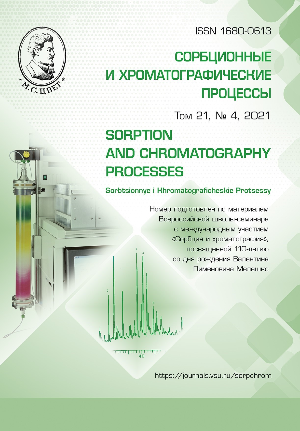Chromatographic determination of organohalogen compounds in swimming pool water
Abstract
The purpose of the work was to search for a sorbent with good selective properties for water purification. For this purpose, we determined the organohalogen compounds in the water of a swimming pool. A method of gas-liquid chromatography was used, using packed and capillary chromatographic columns. To concentrate the impurities of the organohalogen compounds, an automatic vapour-phase dispenser was used. This established that the swimming pool water, taken in the evening, had a complex composition of components, including 33 organohalogens, which have different toxicities for the human body. These are classed as belonging to the first and second groups of hazards. Identification of the individual component composition was carried out by determining the relative retention times of the test compounds and standard samples of the organohalogen compounds dissolved in methanol. Out of the entire range of the organohalogen compounds contained in the swimming pool water it was determined that the highest concentration of chloroform was 0.024 mg/dm3 and the highest concentration of carbon tetrachloride was 0.018 mg/dm3. The total content of organohalogen substances in the swimming pool water was 0.370 mg/dm3, which increases the risk of human diseases while the swimming pool is in operation. It is proposed to clean the water in the swimming pools from toxic impurities by an adsorption method using rocks containing zeolite from the Tatar-Shatrashan deposit, which are characterized by a sufficiently high sorption capacity in relation to the organohalogen compounds.
Downloads
References
Keuten M.G.A., Peters M.C.F.M., Daanen H.A.M., Kreuk M.K.D. et al., Water Res., 2014, Vol. 53, pp. 259-270. DOI:10.1016/j.watres.2014.01.027
Richardson S., Ternes T.A, Anal. Chem., 2011, Vol. 3, pp. 4614-4648. DOI: 10.1021/ac200915r
Gunther L.I., Alekseeva L.P., Pet-ranovskaya M.R., Chemistry and technology of water, 1985, Vol. 5, pp. 10-13.
Taneeva A.V., Vu Ngoc Zun, Nguyen Zui Hyng, Dmitrieva A.V., et al., Sorbtsionnye I khromatograficheskiye protsessy, 2019, Vol. 19, No 5, pp. 566-572. DOI: https://doi.org/10.17308/sorpchrom.2019.19/1171
Buszewski B., Ligor T., Water, Air, Soil Pollution, 2001, Vol. 129, No 1-4, pp. 155-165.
Novikov V.F., Kartashova A.A., Taneeva A.V. Instrumental methods of analysis In three parts. Gas chromatographic control of production processes in power engineering, Kazan, Kazan state power engineering. uni-ty, 2018, Pt III, 328 p.
Ruiz-Bevia F., Fernandes-Torres M.J., Blasco-Alimany M.P., Anal. Chim. Acta, 2019, Vol. 632, No 2, pp. 304-314. DOI:10.1016/j.aca.2008.11.022
Khamidullina E.A., Timofeeva C.V., Davydkina O.A., Voda i ekologiya: problemy i resheniya, 2015, No 1, pp.10-18.
Lygina T.Z., Mikhailova O.A., Naum-kina N.I., Gubaidullina A.M. et al., Georesources, 2015, Vol. 1, No 4(63), pp. 56-63.
Kirichenko V.E., Pervova M.G., Pashkevich K.I., Rus. Chem. J. (J. Rus. Chem. Soc. D.I.Mendeleev), 2002, Vol. 46, No 4, pp.18-27.







